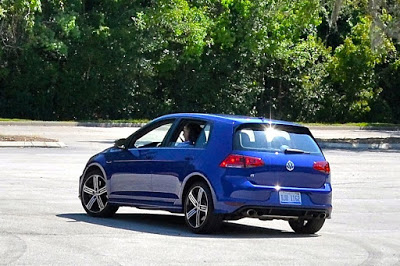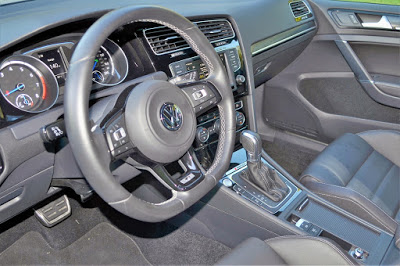I realized that my blue 4-door Golf R is a muscle car and a family car when I parked it between a replica Cobra and a ’57 Ford Fairlane. The 292-inch, 206 horsepower Fairlane could sprint to 60 mph in 11.2 seconds. A real 427 Cobra would take 4.5 seconds to get to 60 mph. The turbocharged 292 horsepower VW could go to 60-mph in under-5 seconds.The Golf R is a modern hatchback that could do what its cruise-in mates did – haul people and haul, period!
The Volkswagen Golf R’s turbocharged, direct-injected TSI two-liter four-cylinder engine is hooked to a twin-clutch DSG automatic gearbox and 4Motion all-wheel-drive. There’s 280 pound-feet of torque available from 1,800 to 5,500 rpm. With the dual-clutch direct-shift gearbox, it’s almost a second quicker to 60-mph than a manual-equipped version, two independent gearbox units allowing for a quick gear change with no interruption in power.
The DSG has “Normal” and “Race” driving modes, along with an “Individual” so the driver can program “Sport” or “Normal” into steering, engine, cornering lights and exhaust note individually. The transmission has its own “Sport” mode, which lets the DSG hold on to the gears for longer, as well as shifting down earlier as necessary. Or you can paddle shift, each downshift getting an engine blip.
4Motion is normally front wheel drive under low load, or give it the gas and the rear wheels engage quickly via the Haldex coupling. That means up to a maximum of 50 percent drive at the rear axle. The Golf R’s XDS cross differential locks the front and rear and also allows transfer of drive power to the wheel on the opposite side in turns. That plus peak torque down low equates to very quick launches to 60 mph in 5.5 seconds in “Normal, and 100 mph in 13 seconds. Shift to “Race,” deactivate stability control, let the turbo boost come on line and 60-mph showed in 4.5 seconds. Shifts become razor sharp with an exhaust whoomp and snarl – actually electronically pumped up through the speakers. Fuel mileage on premium averaged 20-mpg in “Normal,” but dropped to 17-mpg in “Race” mode.
A strut-type front suspension has a newly developed lower control arm, with a multi-link rear with different toe-link bearing tuning. “Normal” offers a comfortable but firm suspension, just fine for daily driving. Bumps were handled with a quick but buffered rebound. Since I toggled steering and engine to “Sport,” then tapped “Individual,” we had a much tighter and responsive steering feel and firmer suspension damping. Surprising livable on most roads, there was a bit of very firm buffering to cushion rebound off bumps.
But with all systems in “Sport” and the 4Motion dividing and conquering, the R came alive and responded to my inputs like it was wired to me. Throw the R into a turn and it cornered as if on rails, just a touch of body roll, the bucket seat holding me securely. Accelerate off a stop sign into a turn, and no understeer – the R just grabbed and went like it was glued. And when we played in the autocross with the car in “Race,” it just hung on with a slight controllable understeer, then the rear wheels would play to neutralize when we added some juice. Tap the stability control button to let it back off a bit and we could let the R drift on the skidpad, letting the 4Motion play. Or fully deactivate it for track driving with a 3-second hold of that button.
The R was fun and so controllable – just point, shoot and carve a corner. The power steering was precise, with a very tight 2.1 turns lock-to-lock, compared with 2.75 turns for other Golf models. The 13.4-inch front/12.2-inch rear discs with black R-logo calipers had a very precise pedal feel on our 10,000-mile-old test car. They hauled the R down straight and short with no fade time after time.
VW’s Golf has the same basic shape of all seven generations of Golf and Rabbit, namely a simple two-box hatchback. This latest design was introduced in 2013 in Europe, then 2015 in the U.S. The R alters a few things, subtle but sharpening an already clean look. Low-profile Bridgestone Potenza P225/40R18-inch performance rubber on 5-spoke alloy wheels accent the R’s .8-inch ride height drop. It adds a sinister slammed look, wide rubber peeking out of each corner.
Up front, the base Golf’s front bumper gets a new design as LED daytime running lights offer U-shaped rings around the headlights. The deep black lower air intake has a chrome-edged air dam, while functional side vents let you see intercooler and oil cooler behind. That “R” fender vent doesn’t do anything – it’s just jewelry. The taillights get square LED elements, while the reshaped rear bumper has a lower aero piece and dual chrome exhaust tips per side. The VW Golf R is a subtly aggressive, practical shape with just enough attitude to look cool.
The driver’s door opens wide, and you settle into superbly supportive and firm black leather sport seats with power adjustment and “R” logo embroidering. There’s a familiar look to the dash under the padded black top, precisely done with the R additions of gloss black, brushed alloy and a carbon fiber-like trim accenting the cabin. The driver gets a stitched leather-clad flat-bottom “R” logo sport steering wheel. Fire up the R via the satin alloy start button on the center console and the blue tachometer and speedometer needles sweep across their faces. The gauge design is familiar, but with a 200-mph speedometer and 8,000-rpm tach (6,500-rpm redline). In between is the trip computer display.
There’s room for two adults in back. The rear hatch opens high to a flat and fairly deep cargo area, with rear seatbacks that split and fold for more room. It’s a precision-made, precise-looking, well-designed German interior with sporty seats and room for lots.
A base Golf 1.8T 3-door with 170-horsepower four and manual transmission starts at $19,315, while our R tester had an MSRP of $37, 570. Pricey, but fast, furious and fun!









